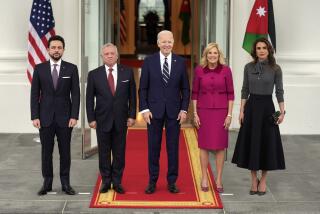Israelis Cheer Jordanian King’s First Public Visit : Mideast: At a ceremony in Galilee region, Hussein and Rabin sign ratified copies of peace pact. A new border crossing is opened.
- Share via
TZEMACH, Israel — A beaming King Hussein, making his first public visit to Israel, stepped out of a helicopter Thursday into a throng of cheering schoolchildren waving Israeli and Jordanian flags.
Surrounded by a phalanx of security men, the Jordanian monarch walked several hundred yards here at the southern tip of the Sea of Galilee alongside Israeli Prime Minister Yitzhak Rabin, down a road lined with hundreds of ecstatic children and watchful soldiers.
“Hussein! Hussein!” the children shouted. Some sang “Havenu Shalom Aleichem,” a popular Israeli song of welcome and peace.
Buffered by the security men, Hussein had little physical contact with the children. But his less tightly guarded brother, Crown Prince Hassan, earned squeals of delight from the children when he reached into the crowd to shake hands.
“It’s like a dream come true,” said Betty Fessler, 50, who immigrated 12 years ago from Pasadena to Kibbutz Massada, half a mile from the Jordanian border. “Hussein is a very, very sensible leader, very pragmatic. I think he is probably even happier about this than we are.”
“We’ve been looking for this moment for a long time,” said Tali Tal, a teacher who lives on a cooperative farm in the Galilee region. Tal brought her two daughters, 15-year-old Hadar and 10-year-old Zohar, to see the king.
“I was 10 years old in 1967, and I remember the war then,” Tal said. “There were bombs dropping all around, and we were in a hole in our garden.
“To come from there to here,” she said, shaking her head in disbelief. “All my life, I have wanted peace. It is very easy for me to welcome the king. There are no hard feelings.”
Hussein’s contact with non-official Israelis was brief. His short walk led to the manicured grounds of Beit Gabriel, a cultural center on the shores of the Sea of Galilee built by Geta Sherover, a wealthy philanthropist.
“Mrs. Sherover had a vision,” said Anat Fonarov, general director of Beit Gabriel. “She thought that one day, we will host here our neighbors. Now, we are waiting for (Syrian President Hafez) Assad to come.”
At a gilt-edged table on the lakeside, in the mellow glow of a late afternoon sun, Hussein and Rabin signed ratified copies of the Israeli-Jordanian peace treaty first signed Oct. 26 in the Arava desert, with President Clinton as a witness.
The Jordanian Senate ratified the treaty Wednesday. Thursday morning, four hours before Hussein and Rabin met, the two nations opened a new border crossing over the Jordan River about 60 miles north of Jerusalem. The Jordanians call the crossing the Sheik Hussein Bridge; the Israelis call it the Jordan River Bridge.
Citizens of the two nations will be able to obtain visas and cross freely in another week. Ambassadors are expected to be exchanged within a month.
A team of senior officials from the Israeli Foreign Ministry plans to travel next week to Amman, the Jordanian capital, to search for a site for the Israeli Embassy and to finalize arrangements for issuing visas. “I thank God the almighty for blessing us both with the ability to see our long and objective march through to its conclusion,” Hussein said in a brief speech after the ratification.
Stepping to the podium after the king, Rabin turned toward the monarch as he spoke. “I believe our aspiration is to achieve a comprehensive peace, for the purpose of having an entirely different Middle East,” Rabin said. “You led your country with courage, imagination and vision. You led your country and your people under difficult times. It is a day when we celebrate together.”
Rabin said he hoped that Syria and Lebanon will soon follow Jordan in making peace with Israel.
The two leaders then held a brief working meeting but no news conference. Hussein wanted to keep the session low-key, according to Jordanian officials, because the treaty continues to draw criticism in Jordan. Islamic fundamentalists there and elsewhere in the region say the treaty failed to secure Jordan’s rights and that it grants Israel too many economic advantages in trade with Jordan.
Other Jordanians also have criticized the accord. Ahmed Obeidat, a former prime minister and staunch supporter of the regime, resigned from his Senate seat--to which he was appointed by Hussein--on Wednesday to protest the treaty.
The Israeli-Jordanian pact also has been criticized by Palestinians, who fear that Israel and Jordan are making decisions without their participation that ultimately will affect the 1.2 million Palestinians living in the West Bank and East Jerusalem.
Palestine Liberation Organization Chairman Yasser Arafat--who has been on bad terms with Hussein for months--reached out to the king Wednesday night, telephoning him for the first time since Arafat moved to Gaza in July to head the self-governing Palestinian Authority there.
“It was decided that contacts between them would continue,” said Nabil abu Rudeineh, a spokesman for Arafat. Palestinian officials said Arafat may travel to Amman soon to meet with Hussein. The two have publicly sniped at each other recently over who should protect Muslim holy sites in East Jerusalem, and over the nature of future ties between the Palestinian-run territories and Jordan.
It was no accident, Israeli analysts said Thursday, that Hussein decided to make his first visit to Israel one to an obscure site in the north.
He stayed far away from Jerusalem, where Palestinians are sharply critical of him and might have publicly protested his visit.
More to Read
Sign up for Essential California
The most important California stories and recommendations in your inbox every morning.
You may occasionally receive promotional content from the Los Angeles Times.













